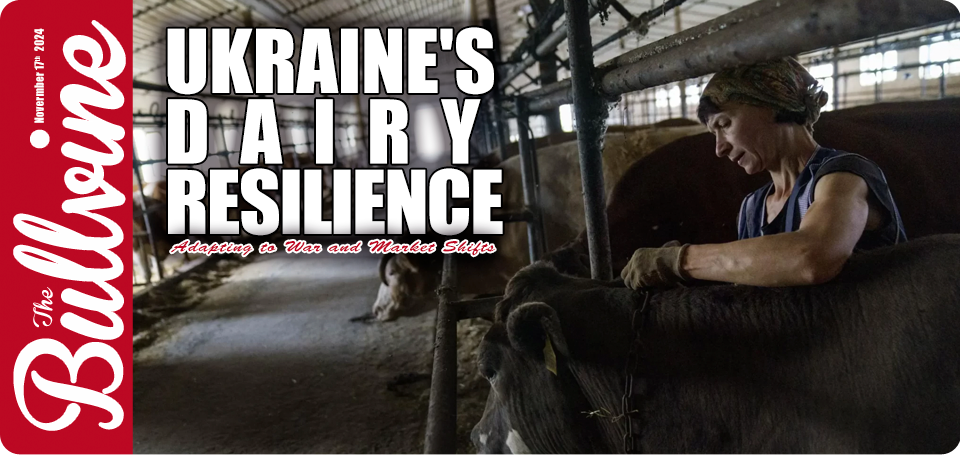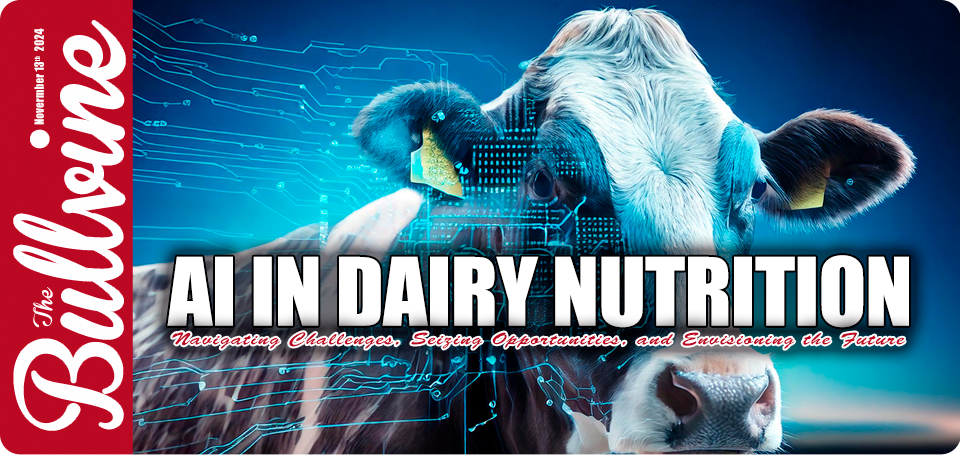Latest News
Resilient Dairy Surge: U.S. Milk Output Climbs Despite California Hurdles
Explore how U.S. dairy thrives despite California's hurdles. What tactics help farmers boost milk output? Summary: The latest USDA Milk Production report&n […]Why Milk Reigns Supreme: A Deep Dive into Nutritional Superiority Over Plant-Based Alternatives
Milk wins on nutrition. Are you making the healthiest choice? Discover new study insights. Summary: A recent University of Minnesota School of Public Healt […]Navigating Germany’s Biotech Frontier: Is Dairy Farming Ready for a Genetically-Engineered Revolution?
Germany stands at the biotech frontier—how ready is dairy farming for this genomic leap? Uncover what this could mean for your farm and the future of […]Top 5 Teamwork Secrets Every Dairy Farmer Needs to Know
Discover the top 5 teamwork secrets every dairy farmer needs to know. Ready to boost your farm's productivity and harmony? Dive into these essential t […]Class IV, Butter, and NFDM Set New Limits Amid Market Volatility: What’s Next for Dairy Farmers?
How will expanded limits on Class IV, Butter, and NFDM impact dairy farmers amid market shifts? Summary: Today marks a significant shift in the dairy […]
More News
- How China’s Dairy Future is Shaping Global Markets: Insights and Forecasts for 2025
- Global Milk Production on the Rise: How Top Exporters Overcame Challenges in 2024
- Global Dairy Markets: Navigating Surplus Challenges and Protein Demand
- MIT Shines Spotlight on CRISPR: A New Era for Cattle Genetics and Climate Change Solutions
- Nordic Dairy Warning: Bluetongue Disease Strikes Denmark, Norway, and Sweden
- Why Japan’s Tourism Revival is a Golden Opportunity for the U.S. Dairy Industry
- Dairy Markets Brace for Winter: Surplus Cheese and Butter, Rising Whey and Milk Powder Prices
- How Indonesia’s Expanding Dairy Market is Shaping the Future for Farmers and Exporters
- How Food Inflation Squeezes Dairy Farmers and Consumers Alike
- Dairy Market Rollercoaster: EU Butter Boom, U.S. Cheese Slump & Global Trade Shifts
Top News Posts from Past Week
- Top 10 Best Places to Farm in the U.S. Revealed by 20-Year USDA Study
- Michigan Farm Forced to Destroy Raw Dairy Products Amid Violations of State Laws
- The conspiracy to stop us drinking real milk
- Meet Viatine-19: The World’s Most Expensive Cow Worth $4 Million
- Joel Phoenix Shines as 2024 Curtis Clark Achievement Award Winner
- Farmers Stand In Silence At Auction So A Young Man Can Buy Back His Family Farmhouse
- Nordic Dairy Warning: Bluetongue Disease Strikes Denmark, Norway, and Sweden
- US Cold Storage Report October 2024: Surprising Cheese Shortages and Unexpected Butter Surplus Impact Dairy Markets
- The Secret Raw Milk Cure Hidden by Big Pharma
- How Many Cows Do You Need to Keep Your Dairy Farm Profitable? Find Out Here!
Feature Articles
How Staff Shortages Are Silently Raising Stillbirth Rates on Your Dairy Farm!
Explore the connection between a dwindling workforce and climbing stillbirth rates on dairy farms. How can farmers solve this costly issue and secure their […]Navigating the Double-Edged Sword of Borrowing: Debt Management for Dairy Farmers
Are you facing farm debt? Learn practical tips to manage it and keep your dairy farm financially healthy. Ready to take charge? E61 Navigating the Dou […]Beef Prices Soar: How Dairy Farmers Are Rethinking Breeding Strategies
Explore how high beef prices are changing daily strategies. Are crossbred calves the future? Uncover the changing landscape of the industry. E60 Beef Prices Soa […]Experience the Future of Dairy Farming: Don’t Miss the 79th International Livestock Exhibitions in Cremona!
Explore dairy farming's future at Cremona's 79th Livestock Exhibitions. Ready for innovation and networking? E58 Experience the Future of Dairy Farming: Don’t M […]Ukraine’s Dairy Resilience: Adapting to War and Market Shifts
Discover how Ukraine's dairy sector faces challenges and finds opportunities amid conflict. How can farmers respond to declining output and changing consumer ne […]
More Articles
- Argentina’s Dairy Dilemma: Navigating Weather Woes and Economic Tides
- Is Erbacers Snapple Shakira One of the Greatest Show Cows of All Time?
- Rethinking Cow Health: How Immune Activation Shapes Transition Dairy Cow Performance
- AI in Dairy Nutrition: Navigating Challenges, Seizing Opportunities, and Envisioning the Future
- The Hidden Benefits of Lying Time: Boosting Dairy Cow Welfare and Productivity
- The Royal Winter Fair 2024 – Jersey
- The Royal Winter Fair 2024 – Holstein
- The Royal Winter Fair 2024 – Red & White Holstein
- The Royal Winter Fair 2024 – Ayrshire Show
- How Trump’s Re-Election Will Redefine the Dairy Industry
Top Feature Articles from the Past Month
- The Royal Winter Fair 2024 – Holstein
- International Holstein Show 2024
- The Royal Winter Fair 2024 – Red & White Holstein
- Ontario Summer Holstein Show 2024
- Jersey vs. Holstein: Which Dairy Breed Delivers Greater Profitability for Farmers?
- TD Canadian 4-H Dairy Classic
- Le Supreme Dairy Show – Holsteins 2024
- How Huronia Centurion Veronica 20J Redefined the Jersey Breed
- Emulating Ryan Rash: The Dire Need for Revolutionizing Dairy Cattle Judging Standards
- The Royal Winter Fair 2024 – Jersey
- How Staff Shortages Are Silently Raising Stillbirth Rates on Your Dairy Farm!
-
How Staff Shortages Are Silently Raising Stillbirt…
Andrew Hunt Nov 21, 2024Explore the connection between a dwindling workforce and climbing stillbirth rates on dairy farms. How can farmers solve this costly issue and secure their futures? E62 How Staff Shortages Are Silently Raising Stillbirth Rates on Your Dairy Farm! Have you ever wondered why stillbirth rat… Read More - Navigating the Double-Edged Sword of Borrowing: Debt Management for Dairy Farmers
-
Navigating the Double-Edged Sword of Borrowing: De…
Andrew Hunt Nov 20, 2024Are you facing farm debt? Learn practical tips to manage it and keep your dairy farm financially healthy. Ready to take charge? E61 Navigating the Double-Edged Sword of Borrowing: Debt Management for Dairy Farmers Debt in dairy production can be both a lifeline and a collapse. Howev… Read More
- Beef Prices Soar: How Dairy Farmers Are Rethinking Breeding Strategies
-
Beef Prices Soar: How Dairy Farmers Are Rethinking…
Andrew Hunt Nov 19, 2024Explore how high beef prices are changing daily strategies. Are crossbred calves the future? Uncover the changing landscape of the industry. E60 Beef Prices Soar: How Dairy Farmers Are Rethinking Breeding Strategies The escalation in beef prices has rippled across the agricultural scene,… Read More
- Experience the Future of Dairy Farming: Don't Miss the 79th International Livestock Exhibitions in Cremona!
-
Experience the Future of Dairy Farming: Don’t Miss…
Andrew Hunt Nov 18, 2024Explore dairy farming's future at Cremona's 79th Livestock Exhibitions. Ready for innovation and networking? E58 Experience the Future of Dairy Farming: Don’t Miss the 79th International Livestock Exhibitions in Cremona! Imagine a gathering that seamlessly blends the rich dairy farming tr… Read More
- Ukraine's Dairy Resilience: Adapting to War and Market Shifts
-
Ukraine’s Dairy Resilience: Adapting to War and Ma…
Andrew Hunt Nov 17, 2024Discover how Ukraine's dairy sector faces challenges and finds opportunities amid conflict. How can farmers respond to declining output and changing consumer needs? E57 Ukraine’s Dairy Resilience: Adapting to War and Market Shifts Despite the ongoing conflict, Ukraine's dairy sector has… Read More
- Argentina's Dairy Dilemma: Navigating Weather Woes and Economic Tides
-
Argentina’s Dairy Dilemma: Navigating Weather Woes…
Andrew Hunt Nov 17, 2024Delve into Argentina's dairy hurdles. Climate and economic changes press on production and exports. Gain insights for dairy experts. E56 Argentina’s Dairy Dilemma: Navigating Weather Woes and Economic Tides Argentina's dairy industry is at a crossroads, grappling with the tumultuous… Read More
- Is Erbacers Snapple Shakira One of the Greatest Show Cows of All Time?
-
Is Erbacers Snapple Shakira One of the Greatest Sh…
Andrew Hunt Nov 15, 2024Uncover why Erbacres Snapple Shakira stands among the top dairy show cows of all time. What makes her excel in the competitive dairy arena? E55 Is Erbacers Snapple Shakira One of the Greatest Show Cows of All Time? From the moment she steps into the arena, Erbacers Snapple Shakira captivates… Read More
- Rethinking Cow Health: How Immune Activation Shapes Transition Dairy Cow Performance
-
Rethinking Cow Health: How Immune Activation Shape…
Andrew Hunt Nov 14, 2024Learn how immune activation affects your transition cows. Are outdated ideas limiting your farm's success? Find fresh insights now. E54 Rethinking Cow Health: How Immune Activation Shapes Transition Dairy Cow Performance Do the problems transition cows face come down to just high NEFA levels… Read More
- AI in Dairy Nutrition: Navigating Challenges, Seizing Opportunities, and Envisioning the Future
-
AI in Dairy Nutrition: Navigating Challenges, Seiz…
Andrew Hunt Nov 13, 2024How will AI change dairy nutrition? What are the hurdles and chances we'll face? See how AI might shape your dairy farm's future. E53 AI in Dairy Nutrition: Navigating Challenges, Seizing Opportunities, and Envisioning the Future Imagine a world where precision in dairy nutrition isn't j… Read More
- The Hidden Benefits of Lying Time: Boosting Dairy Cow Welfare and Productivity
-
The Hidden Benefits of Lying Time: Boosting Dairy…
Andrew Hunt Nov 12, 2024Maximizing lying time is the key to healthier, more productive dairy cows. Let's ensure your herd gets the rest it needs. E52 The Hidden Benefits of Lying Time: Boosting Dairy Cow Welfare and Productivity Have you ever considered how a comfortable cow can impact your bottom line? Keeping your… Read More
Tanbark Trail
Is Erbacers Snapple Shakira One of the Greatest Show Cows of All Time?
Uncover why Erbacres Snapple Shakira stands among the top dairy show cows of all time. What makes her excel in the competitive dairy arena? E55 Is Erbacers Snapple Shakira One of the Greatest Show Cows of All Time? From the moment she steps into the […]The Royal Winter Fair 2024 – Jersey
Judge Jeff Sales NTENSE JOEL DELPHIE ETGrand ChampionThe Royal - Jersey Show 2024WEEKSDALE/HI-CALIBER/ROCK ALLEN/F&D BORBA, BREADALBANE, PE c LEACHLAND VIDEO MOCHA K Intermediate Champion The Royal - Jersey Show 2024 WEEKSDALE HOLSTEINS, BRE […]The Royal Winter Fair 2024 – Holstein
Judge Blair Weeks JEFFREY-WAY HARD ROCK TWIGS Grand Champion The Royal - Holstein Show 2024 K. DOEBERIENER, L. BOWEN & PAT CONROY, R&F LIVESTOCK INC, & WALKER DAIRY INC. Grand Champion: Jeffrey-Way Hard Rock Twigs, 1st 4-year-old, K Doebe […]The Royal Winter Fair 2024 – Red & White Holstein
November 4th 2024 Judge: Markus Hehli, Rimbey, AB PREMIUM APPLE CRISP LILLY Grand Champion The Royal - Red & White Holstein Show BUTLERVIEW FARM, CHEBANSE, IL Grand Champion: Premium Apple Crisp Lilly (Apple-Crisp), 1st 5-year-old, Butlerview Farm, C […]TD Canadian 4-H Dairy Classic
November 4th 2024 Judge: Curtis McNeil, ON JUNIOR SHOWMANSHIP, 12-14 years old McKenzie Howard, Burgessville, ONHODGLYNN ACTIONMAN HARISSA, HOCANF14971465 Emily Smygwaty, Russell, ONKINGSWAY WARRIOR LOOKOUT, HOCANF14798896 Alyson […]
The Bullvine LLC © 2024 | Terms of Use | Community Guidelines | Privacy Policy |
Manage Consent
To provide the best experiences, we use technologies like cookies to store and/or access device information. Consenting to these technologies will allow us to process data such as browsing behavior or unique IDs on this site. Not consenting or withdrawing consent, may adversely affect certain features and functions.
Functional Always active
The technical storage or access is strictly necessary for the legitimate purpose of enabling the use of a specific service explicitly requested by the subscriber or user, or for the sole purpose of carrying out the transmission of a communication over an electronic communications network.
Preferences
The technical storage or access is necessary for the legitimate purpose of storing preferences that are not requested by the subscriber or user.
Statistics
The technical storage or access that is used exclusively for statistical purposes.
The technical storage or access that is used exclusively for anonymous statistical purposes. Without a subpoena, voluntary compliance on the part of your Internet Service Provider, or additional records from a third party, information stored or retrieved for this purpose alone cannot usually be used to identify you.
Marketing
The technical storage or access is required to create user profiles to send advertising, or to track the user on a website or across several websites for similar marketing purposes.
































